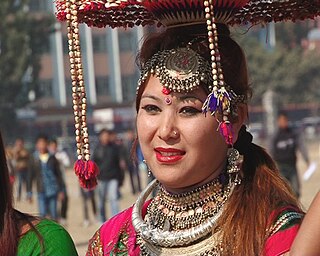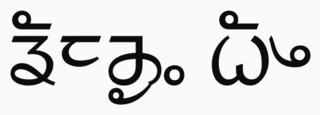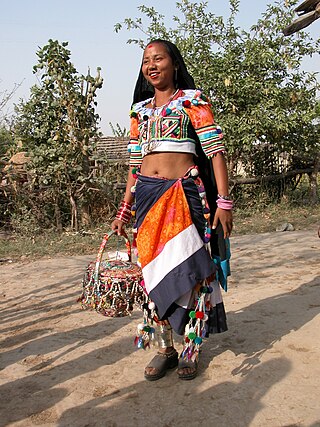Related Research Articles

The Indo-Aryan languages are a branch of the Indo-Iranian languages in the Indo-European language family. As of the early 21st century, they have more than 800 million speakers, primarily concentrated east of the Indus river in Bangladesh, India, Pakistan, Sri Lanka, Maldives and Nepal. Moreover, apart from the Indian subcontinent, large immigrant and expatriate Indo-Aryan–speaking communities live in Northwestern Europe, Western Asia, North America, the Caribbean, Southeast Africa, Polynesia and Australia, along with several million speakers of Romani languages primarily concentrated in Southeastern Europe. There are over 200 known Indo-Aryan languages.
Bihari languages are a group of the Indo-Aryan languages. The Bihari languages are mainly spoken in the Indian states of Bihar, Jharkhand, Uttar Pradesh, and West Bengal, and also in Nepal. The most widely spoken languages of the Bihari group are Bhojpuri, Magahi and Maithili.

The Tharu people are an ethnic group indigenous to the Terai in southern Nepal and northern India. They speak Tharu languages. They are recognized as an official nationality by the Government of Nepal. In the Indian Terai, they live foremost in Uttarakhand, Uttar Pradesh and Bihar. The Government of India recognizes the Tharu people as a scheduled Indian tribe.

Limbu is a Sino-Tibetan language spoken by the Limbu people of Nepal and Northeastern India as well as expatriate communities in Bhutan. The Limbu refer to themselves as Yakthung and their language as Yakthungpan. Yakthungpan has four main dialects: Phedape, Chhathare, Tambarkhole and Panthare dialects.
The Magar language or Magar ḍhuṭ is a Sino-Tibetan language spoken mainly in Nepal, southern Bhutan, and in Darjeeling, Assam and Sikkim, India, by the Magar people. It is divided into two groups and further dialect divisions give distinct tribal identity. In Nepal 810,000 people speak the language. Despite Magars not having a state for its own country the Magar language is an additional official language in Gandaki Province, Nepal and the Indian state of Sikkim.

Tamang is a term used to collectively refer to a dialect cluster spoken mainly in Nepal, Sikkim, West Bengal (Darjeeling) and North-Eastern India. It comprises Eastern Tamang, Northwestern Tamang, Southwestern Tamang, Eastern Gorkha Tamang, and Western Tamang. Lexical similarity between Eastern Tamang and other Tamang languages varies between 81% and 63%. For comparison, the lexical similarity between Spanish and Portuguese is estimated at 89%.
Khaling is a Kiranti language spoken in Solukhumbu district, Nepal and Sikkim, Darjeeling, and Kalimpong in India. It is one of the few Kiranti languages with tonal contrasts, which are of secondary origin.

South Asia is home to several hundred languages, spanning the countries of Afghanistan, Bangladesh, Bhutan, India, Maldives, Nepal, Pakistan, and Sri Lanka. It is home to the third most spoken language in the world, Hindi–Urdu; and the sixth most spoken language, Bengali. The languages in the region mostly comprise Indo-Iranic and Dravidian languages, and further members of other language families like Austroasiatic, and Tibeto-Burman languages.

The Tharu or Tharuhat languages are any of the Indo-Aryan languages spoken by the Tharu people of the Terai region in Nepal, and neighboring regions of Uttarakhand, Uttar Pradesh and Bihar in India.
The Baram–Thangmi languages, Baram and Thangmi are Tibeto-Burman languages spoken in Nepal. They are classified as part of the Newaric branch by van Driem (2003) and Turin (2004), who view Newar as being most closely related to Baram–Thangmi.
Most of the languages of Bihar, the third most populous state of India, belong to the Bihari subgroup of the Indo-Aryan family. Chief among them are Bhojpuri, spoken in the west of the state, Maithili in the north, Magahi in center around capital Patna and in the south of the state. Maithili has official recognition under the Eighth Schedule to the Constitution of India. The official language of Bihar is Modern Standard Hindi, with Standard Urdu serving as a second official language in 15 districts.

Aimol, also known as Aimual, is a Sino-Tibetan language spoken by the Aimol people of Manipur, India. It is considered endangered and has less than 9,000 speakers worldwide as per 2011 census. The speakers of this language use Meitei language as their second language (L2) according to the Ethnologue.
Tsum is a language from the subgroup of Tibetic languages spoken by the Tsum people primarily in the Tsum Valley of the Gorka District of Nepal. The language is also known as Tsumke.
Kochila Tharu, also called Morangiya, Septari or Saptariya Tharu, Madhya-Purbiya Tharu, and Mid-Eastern Tharu, is a diverse group of language varieties in the Tharu group of the Indo-Aryan languages. The several names of the varieties refer to the regions where they dominate. It is one of the largest subgroupings of Tharu. It is spoken mainly in Nepal with approximately 250,000 speakers as of 2003. In addition to language, cultural markers around attire and customs connect individuals into the ethnic identity Kochila.

Nubri is a Tibeto-Burman language spoken by about 2000 ethnically Tibetan people living in Nubri Valley in northern Central Nepal, upper Gorkhā District of Gandaki Province. Nubri has at least three dialects as typified by the Prok, Lho and Sama village varieties. Nubri is largely undocumented and undescribed, with the exception of a lexicon. Nubri is perhaps most closely related to neighbouring Tsum language and the Kyirong variety of Tibetan spoken just across the border in Tibet. It has also been claimed to be closely related to Gyalsumdo. Like these languages it is tonal and shares many Tibetic grammatical features, but is uniquely different in many ways.

Lhowa (ल्होवा), also known as Loke Tibetan, Mustang Tibetan and Lhopa is a Sino-Tibetan language spoken by approximately 3,000 Tibetan people of Mustang District in central Nepal.

Rana Tharu is an ethnic group generally classified as part of the Tharu people of Nepal and India. They are living in Kailali and Kanchanpur Districts of the far western Nepali Terai and also in India, in Udham Singh Nagar district, Uttarakhand and Kheri district of Uttar Pradesh. As of 2001, Rana Tharu people were the largest of five scheduled tribes in Uttarakhand, with a population of 256,129 accounting for 33.4% of all scheduled tribes.
Danguara Tharu also known as Dangauli Tharu, Dangora Tharu, or Dangura Tharu is one of the Tharu languages spoken by the Tharu people in the Dang, Kapilvastu, Banke, and Bardiya districts of the Lumbini Province and in Kailali and Kanchanpur district of Sudurpaschim Province of Nepal, primarily in the Western Terai Region as well as in Bahraich, Gorakhpur, and Lakhimpur Kheri districts of Uttar Pradesh in India.
Kathariya Tharu also known as Kathoriya Tharu is one of the Indo Aryan languages spoken by the Tharu people of Nepal and India. It is a language spoken in the Sudurpashchim Province of Nepal, particularly in the Kailali District, including areas like Bardagoriya, Bhajani, Ghodaghodi, Joshipur. Additionally, it is spoken in the Uttar Pradesh state of India, specifically in Bahraich and Lakhimpur Kheri districts near the Nepal border.
The Sonha language also known as Sonaha, Sunha, or Sunah is an Indo-Aryan language spoken by the Sonha people in Lumbini Province, specifically in Bardiya District, covering Geruwa and Rajapur municipalities. It is also spoken in Sudurpashchim Province, particularly in Kanchanpur District and Bhimdatta of Nepal. Sonha exhibits linguistic similarities with Awadhi, with reported lexical similarities of 69% with Rana Tharu, 73% with Kathariya Tharu, and 72% with Dangaura Tharu. Notably, Sonha and Kathoriya serve as a lexical bridge connecting Rana and Dangaura varieties of Tharu.
References
- ↑ Rana Tharu at Ethnologue (27th ed., 2024)

- ↑ Dhakal, Dubi Nanda. "Notes on Rana Tharu language".
- 1 2 3 "Rana Tharu". Ethnologue. Retrieved December 25, 2023.
- 1 2 3 Dubi Nanda Dhakal. 2015. Analyzed Texts in Rana Tharu: with a Grammatical Sketch. (Languages of the World/Text Collection, 36.) München: LINCOM. 142pp.
- 1 2 Dubi Nanda Dhakal. 2013. The Documentation of Rana Tharu Language. Research report submitted to Nepal Academy, Kamaladi, Kathmandu.